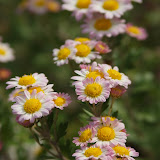Have a look at the album to the right of flower images I shot with D300 and Nikon 105 micro lens. All were shot in the dark of my studio with the sunny WB and no fine tuning of standard plus two saturation of picture control setting. These were shot in near darkness at F16 and ISO 200 at 1/320 with three SB800's shot thru umbrellas as the light source. so they are perfect in terms of not being corruted by differant light sources. The first of each image is the LR conversion from raw to jpg. The second is capture conversion from raw to jpg. (Sorry the caption does make sense I will try to fix it later. )If viewed in nikon Capture the Raw files have identical color to the JPG that you are viewing in this picasa album. RAW viewed in capture NX look better because of increased shadow detail. In LR however the JPG's look better because of superior green's red's and yellows. Some of you may disagree about the yellows. As you view these images on picasa they are identical to how they would appear in LR in terms of color and sharpness had you shot raw plus JPG. The LR jpg's have less shadow detail then when viewed in LR as raw files but THE COLOR AND SHARPNESS IS MY ISSUE not shadow detail. Obviously if LR worked correctly the raw would look the same as they do in in capture which is identical in color and sharpness but with better shadow detail and these images would be identical as they would if prcessed in capture (also I cannot post raw files for you to view).
|
In a perfect world where raw and jpg looked the same and produced the same output in LR and where my computer did not go slower with raw files I would shoot raw all the time. Fact is LR is the best processing software but it does not get color right in raw files. NX nails the colors but sucks for everything but converting JPG and fixing nikon 10.5 images.
If only LR could handle raw like a camera company software does I would not be whining and trying to decise what format to shoot in. Please note my observations and if you agree let's all start riding adobe to fix this. Please site my observations far and wide. Next up is a studio shoot with skin tones.
Kenrockwell.com has some great facts about JPG on his website but I have never seen anyone post observations like mine on the web.
My conclusion is not that we should never shoot raw but that we understand the limitations of color and sharpness of raw files if processed in anything other than the camera companies software.


.jpg)